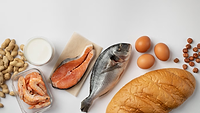Threshold-Based Precautionary Allergen Labeling Could Increase Food Safety, Choice for Allergic Consumers

Image credit: Freepik
Precautionary allergen labeling (PAL) is a tool meant to protect allergic consumers from accidentally eating foods containing undeclared allergens that may cause a reaction, but the overuse and inconsistent application of PAL may have eroded its risk communication efficacy. Although experts, including Codex, have recommended the use of uniform, threshold-based PAL, such an approach has yet to be adopted by industry.
To examine the protective impact that threshold-based PAL would have on allergic consumers, researchers from Laval University and Health Canada conducted computerized simulations to predict the outcomes of different situations. Using input values for four allergens across nine food categories, and considering the Canadian population, the researchers ran simulations for the present-day, real-life use of PAL; as well as two hypothetical scenarios in which PAL is only applied based on allergen concentration thresholds that are protective of 99 percent (ED01) and 95 percent (ED05) of consumers, assuming that allergic individuals would avoid products with PAL.
The researchers compared the estimated number of allergic reactions that consumption of certain food products with PAL sold in Canada could cause, and compared it to the hypothetical scenarios where PAL is applied using thresholds based on ED01 and ED05 (as recommended by Codex). In the present-day situation, the simulation showed that PAL could be poorly protecting individuals with food allergies, and could also be hindering allergic consumers’ diets by greatly limiting the number of food products available on the market without PAL. Of the allergens and foods included in the study, milk is the allergen that could currently cause the most allergic reactions, and dark chocolate cross-contaminated with milk is the combination that could cause the most allergic reactions. In contrast, PAL for hazelnut could be the most overused or the least effective in protecting Canadian consumers.
Regarding the hypothetical scenarios, use of PAL thresholds based on ED01 could lead to a maximum of 15 allergic reactions per 10,000 eating occasions (EOs) for all studied allergen-food category combinations, and PAL based on ED05 could lead to a maximum of 105 allergic reactions per 10,000 EOs if excluding dark chocolate with milk PAL.
The use of PAL based on ED01 or ED05 could greatly reduce the allergic risk posed to allergic individuals in Canada, especially for products with PAL for milk and egg, which present the largest reduction in the number of estimated allergic reactions. Based on the simulations, the Codex-recommended ED05 threshold would provide, in most cases, an adequate level of protection, would increase the number of safe options for individuals with food allergies, and would strengthen the risk communication efficacy of PAL.
Looking for a reprint of this article?
From high-res PDFs to custom plaques, order your copy today!






